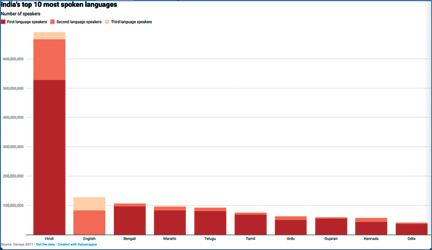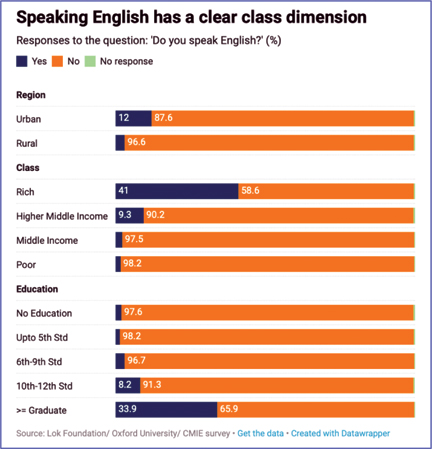Anuradha C
For a country celebrating 75 years of independence from British colonial rule, we are still quite fascinated by the English language! I am trying to pen down a critical piece about the excessive importance given to English proficiency in our school education. But I can’t even imagine writing this piece in any other language.
A significant part of the urban populace in India, however traditionally rooted in Indian culture and ethos, continues to think and converse in English, as a matter of habit. Nothing wrong with that.
Except that at times we forget that English is a foreign language for us Indians, so it is quite natural for our people to falter and stutter with their English. When an individual’s English grammar is found to be wanting or one shows a lack of exposure to Shakespeare and Keats, it must not be construed as a sign of low intelligence.
The language landscape in India
According to the recent GOI census data and a survey conducted by Lok Foundation in 2019, some noteworthy statistics emerge that give us a clear picture on the language landscape prevailing in India.
• Population with English as mother tongue in India is negligible. English is the primary language – mother tongue – of 256,000 people.
• However, English is the second language of 83 million people, and the third language of another 46 million people, making it the second-most widely spoken language after Hindi (which includes more than 50 so-called dialects like Bhojpuri, which is spoken by more than 50 million Indians).
• Hindi is both the most widely spoken first language and second language in India.
• English is also the only language which more speakers use as their second language than first language, pointing to its growing value in work environments and its role as a bridge language.
• Between mother tongue, second and third language, the survey records that over 17% of Indians reported being able to speak some English.
• English speakers are richer, more educated and more likely to be upper caste.
• Speaking English is clearly linked to education – a third of all graduates could speak English.
• Knowledge of English also has a gendered dimension: a higher proportion of men said that they could speak in English.
• Despite the common perception that more people in southern India speak English as a bridge language (rather than Hindi), a higher share of residents of several northern and north-eastern states speak English than in the south.
• Speaking English seems more closely linked with income and religion than geography.

Delivering higher education in a local language
The above data highlights the strong presence of English in school education and formal work environments. But it also gives us a stark reminder – if we want to take education to the large Indian masses, English cannot be the primary mode of communication. If we want formal schooling to penetrate the rural and semi-rural landscape, our education system must adapt to the local language.
The absence of good learning content for higher education in Indian vernacular languages is the biggest deterrent to achieving schooling penetration in deep interior India. Especially when it comes to STEM (Science, Technology, Engineering and Mathematics) education, our vernacular teaching is woefully inadequate. Lack of good quality textbooks, online reference materials, good teachers with a grasp of English and the local language – are all in short supply.
The excuse that English is better suited for technical education is unfounded. Chinese, Russian, French education systems have thriving local language patronage. When these children emerge out of their schooling years, they are qualified on par with English speaking country students. In addition, they also carry a feeling of pride and self-esteem owing to their native language and culture.
Clarity of communication is important, not necessarily in English
What are the most common scenarios where an individual’s English language proficiency becomes a barrier to his/her growth and success? You might be amazed but it’s at several critical junctures of a young one’s life in urban India.
• At school, while seeking admission. Young parents urge kids to speak fluent English before the school interview by feeding them rhymes, stories in English. This is especially tragic when the parents themselves speak poor English, but they feel ‘My child musn’t lose out on what I did not have for myself’.
• Link language among students in school. Since students in India come from disparate language and regional backgrounds, English becomes a convenient common ground. However, working class or lower income groups kids are targeted for their poor command over the language. The intention is not to gang up and hurt those kids, but that just happens inadvertently.
• At sports events, competitions and other inter-school/college group activities. The plight of a young champion from rural India who makes a valiant attempt at giving an acceptance speech in English is a heart-wrenching sight.
• At competitive exams. English vocabulary is a section in several entrance exams. Even logical reasoning, reading comprehension and other cognitive skills are measured using English alone.
• At campus interviews in colleges. A critical part of any job interview is the HR round, where the student’s English proficiency, business communication in English is tested. The massive number of ‘soft skills’ training institutions and online courses thriving at all major Indian cities to give students a last minute English language crash course is a testimony to this fact.

Lucid and effective communication reflects good clarity of thought in an individual. Therefore, it is not wrong to judge a person’s thought process with the words they speak. However, the actual language employed to convey one’s thoughts is just a tool. We must not mix up the two aspects.
By laying excessive emphasis on the language used, we are depriving students from our hinterlands the chance to showcase their intelligence and in the process, stunting their confidence.
The vast English speaking population in India is a definite plus when it comes to our global competence. It’s the biggest enabler why the Indian diaspora thrives in foreign lands. There is no doubt about that. We must continue to sharpen this advantage and master the language. However, English is also playing a disabling hand when it comes to our vast rural youth and their path to higher education and employment.
The key challenge in front of our educators and government bodies is to resolve this dichotomy. The trick lies in identifying and assigning to the English language, the right amount of importance – not more, not less.
The author is an IT industry drop-out after several years of slogging and money-making. She is now working freelance as a corporate technical trainer and content writer. She is hoping to channelize her passion for writing into a satisfying experience for herself and a joyous experience for her readers. She can be reached at anuradhac@gmail.com.
